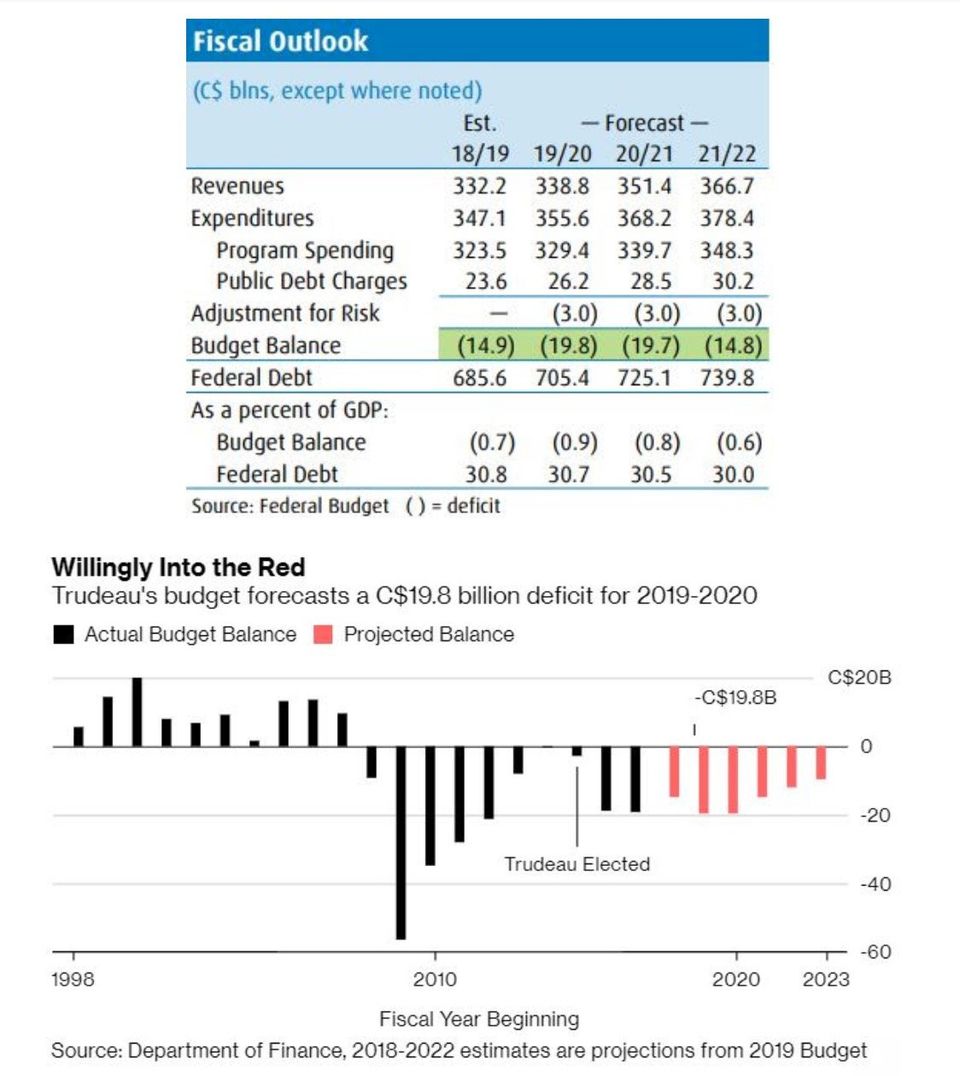What the Canadian Federal Budget did for housing
Michael Hallett • March 28, 2019

Federal Budget 2019--Actions for Homebuyers
In its fourth fiscal plan, the Trudeau government spent its entire revenue windfall leaving the deficit projection little changed. In this election budget, Finance Minister Bill Morneau announced $22.8 billion over six years in new spending initiative mostly for homebuyers, students and seniors. Trudeau promised in his first budget to have eliminated all red ink by this year. He will instead head for an October election with an annual deficit of nearly $20 billion. Ottawa is projecting a string of double-digit deficits through the end of 2022 (see Table and Chart below).
The key debt-to-GDP ratio is expected to be 30.8% this fiscal year and edges downward only very slowly to 30% over the four-year forecast horizon.
Today's budget offered help to young homebuyers, many of whom find it very difficult to afford to purchase in some of our more expensive cities. There were two measures targeted at first-time homebuyers:
Maximum Withdrawal from RRSPs Is Increased
The simplest to understand is the $10,000 increase in the federal Home Buyers' Plan (HBP)maximum tax-free withdrawal from RRSPs to $35,000, effective immediately. This allowable withdrawal for first-time buyers will now also apply to people experiencing the breakdown of a marriage or common-law partnership who don't meet the usual requirement of being a first-time homebuyer.
The new limit would apply to HBP withdrawals made after March 19, 2019.
Those taking advantage of the higher HBP limit will have to keep in mind that the repayment timeline is unchanged. Home buyers must put the money back into their RRSP over 15 years to avoid full ordinary income taxation on HBP withdrawal. Now Canadians using these funds will have to repay a maximum of $35,000 – instead of $25,000 – over the same period.
The Boldest Move: The CMHC First-Time Homebuyer Incentive
A $1.25 billion fund administered by the Canadian Mortgage and Housing Corporation (CMHC) over three years will provide 5% of the cost of an existing home and 10% of the price of a new home through what amounts to an interest-free loan to be repaid when the property is sold. The money would go to first-time home buyers applying for insured mortgages. The key stipulations are:
- Users must have a downpayment of at least 5%, but less than 20%;
- Household income must be less than $120,000;
- The purchase price cannot be more than four times the buyers' household income.
For example, say you’re hoping to buy a $400,000 home with the minimum required 5% down payment, which works out to be $20,000. With the new incentive, you could receive up to $40,000 (for a new home) through the CMHC. Now, instead of taking out a $380,000 mortgage, you’d need to borrow only $340,000. This would lower your monthly mortgage bill from over $1,970 to less than $1,750. The incentive is 10% for buyers purchasing a newly built home and 5% for existing homes.
Homeowners would eventually have to repay this so-called 'shared mortgage,' likely at resale, though it is unclear how this would work. CMHC might share in any capital gain (or loss)-- receiving 5% or 10% of the sale price (not the purchase price). At the time of this writing, these details had not been hammered out.
These stipulations effectively limit purchases under this plan to properties priced at less than $500,000 ($480,000 maximum in insured mortgage and incentive, plus the downpayment), which is close to the national average sales price of $468,350 (which is down 5.2% from the average price one year ago). However, the national average price is heavily skewed by sales in Greater Vancouver and the Greater Toronto Area, two of Canada's most active and expensive markets. Excluding these two markets from the calculations cuts close to $100,000 off the national average price, trimming it to just under $371,000. What this tells us is that the relief for first-time homebuyers is pretty meagre for young people living in our two most expensive regions.
Arguably, the max price point of $500,000 for this plan is where the affordability challenge only really begins in our higher-priced housing markets. The most acute affordability problems surround medium-sized and larger condo units or single-detached homes in the GTA and GVA; yet, most of these are beyond the price range covered by the CMHC plan. The impact, of course, would be broader in other regions, but affordability in many of those is historically quite normal. The most significant impact will be in low-priced new builds.
Also, mortgage applicants under this plan still have to qualify under the federal stress test, which ensures that borrowers will be able to keep up with the payments even if interest rates rise by roughly two full percentage. The incentive, however, would substantially lower the bar for test takers, as applicants would have to qualify for a lower mortgage.
Before the budget, many stakeholders had been arguing that with the rapid slowdown in the economy and the Bank of Canada unlikely to raise interest rates this year, the B-20 stress test is too onerous and should be eased.
The government is hoping to have the plan up and running by September.
Bottom Line: These housing measures are focussed on the demand side of the market, rather than encouraging the construction of new affordable housing. And while the budget does earmark $10 billion over nine years for new rental homes, it does not propose tax breaks or reduced red tape for homebuilders.
This article was written by Dr. Sherry Cooper DLC's Chief Economist.
SHARE
MY INSTAGRAM
Mortgage Brokering meets mountain biking and craft beer. A couple months ago I set for a bike ride with the intention of answering few mortgage related questions, mission accomplished. Any good bike ride pairs nicely with a tasty beer which we enjoyed @parksidebrewery. Hope you see the passion I have for brokering, biking and beer. @torcabikes #mountainbikingmortgagebroker
TEASER alert...at thats what I think they call it in the business. Years ago a wrote a blog called BEERS BIKES AND MORTGAGES. I some how (in my head) blended all 3 topics into 1 blog. Simply put, I enjoy aspects of all 3 with each of them providing something different. I re-united with the talented Regan Payne on a project that I think will shed a bit more light on who I am and what I do. #craftbeer #mountainbike #mortgagebrokerbc #dlccanadainc
I saw this hat on Instagram, that very moment I knew I needed it. As a BC boy born and bred The Outdoorsman hat needed to be added to my collection. As someone who loves BC and most things outdoor, I’m now glad I have a cool hat to wear and fly the flag of BEAUTIFUL BRITISH COLUMBIA. It will be in my bag for all post-exploration celebratory cold pints. If you want to check them out or add one to your collection go to @nineoclockgun ...and yes my facial hair matches the hat as well.
View more

Bank of Canada maintains policy rate at 2.1/4%. FOR IMMEDIATE RELEASE Media Relations Ottawa, Ontario December 10, 2025 The Bank of Canada today held its target for the overnight rate at 2.25%, with the Bank Rate at 2.5% and the deposit rate at 2.20%. Major economies around the world continue to show resilience to US trade protectionism, but uncertainty is still high. In the United States, economic growth is being supported by strong consumption and a surge in AI investment. The US government shutdown caused volatility in quarterly growth and delayed the release of some key economic data. Tariffs are causing some upward pressure on US inflation. In the euro area, economic growth has been stronger than expected, with the services sector showing particular resilience. In China, soft domestic demand, including more weakness in the housing market, is weighing on growth. Global financial conditions, oil prices, and the Canadian dollar are all roughly unchanged since the Bank’s October Monetary Policy Report (MPR). Canada’s economy grew by a surprisingly strong 2.6% in the third quarter, even as final domestic demand was flat. The increase in GDP largely reflected volatility in trade. The Bank expects final domestic demand will grow in the fourth quarter, but with an anticipated decline in net exports, GDP will likely be weak. Growth is forecast to pick up in 2026, although uncertainty remains high and large swings in trade may continue to cause quarterly volatility. Canada’s labour market is showing some signs of improvement. Employment has shown solid gains in the past three months and the unemployment rate declined to 6.5% in November. Nevertheless, job markets in trade-sensitive sectors remain weak and economy-wide hiring intentions continue to be subdued. CPI inflation slowed to 2.2% in October, as gasoline prices fell and food prices rose more slowly. CPI inflation has been close to the 2% target for more than a year, while measures of core inflation remain in the range of 2½% to 3%. The Bank assesses that underlying inflation is still around 2½%. In the near term, CPI inflation is likely to be higher due to the effects of last year’s GST/HST holiday on the prices of some goods and services. Looking through this choppiness, the Bank expects ongoing economic slack to roughly offset cost pressures associated with the reconfiguration of trade, keeping CPI inflation close to the 2% target. If inflation and economic activity evolve broadly in line with the October projection, Governing Council sees the current policy rate at about the right level to keep inflation close to 2% while helping the economy through this period of structural adjustment. Uncertainty remains elevated. If the outlook changes, we are prepared to respond. The Bank is focused on ensuring that Canadians continue to have confidence in price stability through this period of global upheaval. Information note The next scheduled date for announcing the overnight rate target is January 28, 2026. The Bank’s next MPR will be released at the same time.

Following several challenging years, British Columbia’s housing market is beginning to stabilize. Prices, which experienced downward pressure in 2024–2025, have largely plateaued, with some areas showing modest gains. The recent Bank of Canada rate reduction to 2.25% has lowered borrowing costs, improving affordability and supporting market activity. Across the province, housing supply is gradually increasing. Builders are delivering more condos, townhomes, and single-family homes, easing some supply constraints. Meanwhile, population growth, fueled by domestic migration and international immigration, continues to support long-term housing demand. Key Statistics Home sales: BC home sales declined slightly in 2025 by approximately 1.1% to 73,650 units but are projected to rebound in 2026 by around 8.8%, reaching roughly 80,150 units. Average home price: The provincial average price dipped modestly by 0.9% in 2025 to $972,800, with forecasts projecting an increase of 3.2% in 2026 to approximately $1,004,000. Benchmark home price: As of April 2025, the BC benchmark home price stood at $953,500, down 1.3% year-over-year. Listings and inventory: Active listings are expected to exceed 40,000 units in 2025, the highest in more than a decade. Market Forecast 2025: Market remains relatively flat, with modest declines in sales and prices. 2026: Sales and prices begin to recover, with modest upward trends. Early 2027: Market stabilizes, reflecting measured growth and improved affordability. Regional differences will continue. Urban condo markets may see slower price appreciation, while suburban and smaller communities with limited supply could experience stronger gains. What This Means for Buyers and Homeowners Prospective buyers: 2026 is an opportunity to enter a more balanced market with lower interest rates. Current homeowners: Refinancing or mortgage renewal could be advantageous in this period of slightly lower rates. Investors: Localized analysis is critical, as neighborhood inventory and rental demand will determine returns. Bottom Line: BC’s housing market is shifting from a cooling phase toward a period of gradual recovery. Lower interest rates, steady population growth, and increased housing supply point to a healthier, more sustainable market. Buyers, homeowners, and investors should plan strategically, recognizing that while growth is returning, the pace will be measured and regionally variable.








































































































